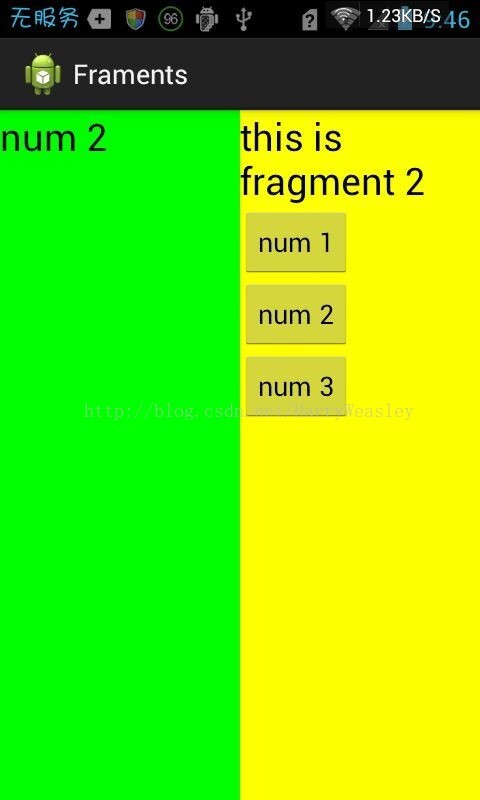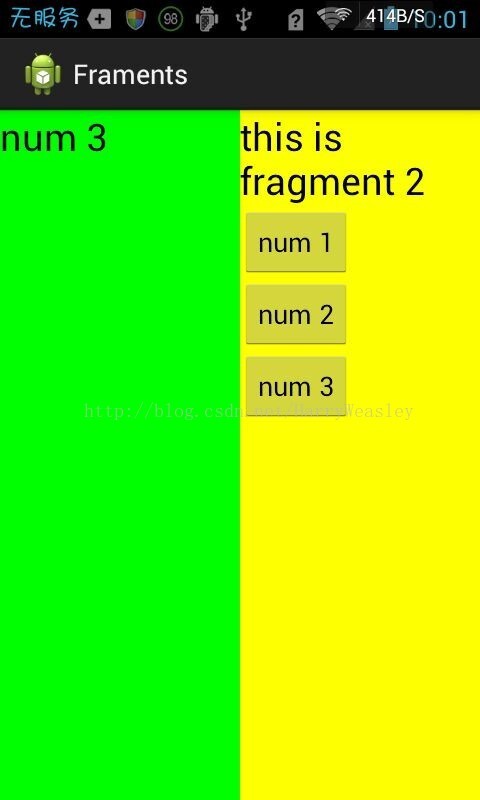
- Android中Android Virtual Device(AVD)使用教程
- Android中自定义ContentProvider实例
- Android手机闹钟用法实例
- Android应用开发中使用Fragment的入门学习教程
- Android重要控件SnackBar使用方法详解
- Android实现个性化的进度条
- 谈谈Android中的Divider是个什么东东
- android中图形图像处理之drawable用法分析
- Android仿外卖购物车功能
- Android如何自定义视图属性
- Android 管理Activity中的fragments
- Android中ViewPager实现滑动指示条及与Fragment的配合
- 详解Android App卸载后跳转到指定的反馈页面的方法
- Android spinner下垃菜单用法实例详解
- android图像绘制(七)ClipRect局部绘图/切割原图绘制总结
- [Android开发视频教学]01_03_say_hello_to_Android
- Android Studio使用教程(二):基本设置与运行
- Android时间选择器、日期选择器实现代码
- 简单学习Android Socket的使用方法
- Android实现固定屏幕显示的方法
- Android学习笔记(二)App工程文件分析
- 轻松实现Android指南针功能
- Android编程四大组件之BroadcastReceiver(广播接收者)用法实例
- Android网络通信的实现方式
- Android远程服务编写和调用教程
- Android组件TabHost实现页面中多个选项卡切换效果
- Android编程添加快捷方式(Short)到手机桌面的方法(含添加,删除及查询)
- android真机调试时无法显示logcat信息的解决方法介绍
- Android编程开发之EditText实现输入QQ表情图像的方法
- Android编程之TabWidget选项卡用法实例分析
Android应用开发中Fragment与Activity间通信示例讲解
首先,如果你想在android3.0及以下版本使用fragment,你必须引用android-support-v4.jar这个包
然后你写的activity不能再继承自Activity类了,而是要继承android.support.v4.app.FragmentActivity,一些其他的父类也有相应的变化.
由于在android的实现机制中fragment和activity会被分别实例化为两个不相干的对象,他们之间的联系由activity的一个成员对象fragmentmanager来维护.fragment实例化后会到activity中的fragmentmanager去注册一下,这个动作封装在fragment对象的onAttach中,所以你可以在fragment中声明一些回调接口,当fragment调用onAttach时,将这些回调接口实例化,这样fragment就能调用各个activity的成员函数了,当然activity必须implements这些接口,否则会包classcasterror
fragment和activity的回调机制又是OOP的一次完美演绎!
下面通过一个例子来说明:
首先,我们看下界面


左边的TextView会根据右边点击button的不同而改变。
下面开始介绍代码:
1.在layout里新建fragment1.xml
<?xml version="1.0" encoding="utf-8"?> <LinearLayout xmlns:android="http://schemas.android.com/apk/res/android" android:layout_width="match_parent" android:layout_height="match_parent" android:background="#00ff00" android:orientation="vertical" > <TextView android:id="@+id/fragment_text" android:layout_width="wrap_content" android:layout_height="wrap_content" android:text="this is fragment 1" android:textColor="#000000" android:textSize="25sp" /> </LinearLayout>
可以看出,这里就只有一个TextView
2.在layout里新建fragment2.xml
<?xml version="1.0" encoding="utf-8"?> <LinearLayout xmlns:android="http://schemas.android.com/apk/res/android" android:layout_width="match_parent" android:layout_height="match_parent" android:background="#ffff00" android:orientation="vertical" > <TextView android:layout_width="wrap_content" android:layout_height="wrap_content" android:text="this is fragment 2" android:textColor="#000000" android:textSize="25sp" /> <Button android:id="@+id/button" android:layout_width="wrap_content" android:layout_height="wrap_content" android:text="num 1" /> <Button android:id="@+id/button2" android:layout_width="wrap_content" android:layout_height="wrap_content" android:text="num 2" /> <Button android:id="@+id/button3" android:layout_width="wrap_content" android:layout_height="wrap_content" android:text="num 3" /> </LinearLayout>
这里是三个button
3.创建类Fragment1继承Fragment
package lgx.fram.framents;
import android.app.Fragment;
import android.os.Bundle;
import android.view.LayoutInflater;
import android.view.View;
import android.view.ViewGroup;
public class Fragment1 extends Fragment {
@Override
public View onCreateView(LayoutInflater inflater, ViewGroup container,
Bundle savedInstanceState) {
return inflater.inflate(R.layout.fragment1, container, false);
}
}
重写onCreateView()方法,这里 return inflater.inflate(R.layout.fragment1, container, false); 这句话是重点
4.创建类Fragment2继承Fragment
package lgx.fram.framents;
import android.app.Fragment;
import android.os.Bundle;
import android.view.LayoutInflater;
import android.view.View;
import android.view.View.OnClickListener;
import android.view.ViewGroup;
import android.widget.Button;
import android.widget.TextView;
public class Fragment2 extends Fragment {
@Override
public View onCreateView(LayoutInflater inflater, ViewGroup container,
Bundle savedInstanceState) {
return inflater.inflate(R.layout.fragment2, container, false);
}
TextView textview;
Button button, button2, button3;
@Override
public void onActivityCreated(Bundle savedInstanceState) {
super.onActivityCreated(savedInstanceState);
button = (Button) getActivity().findViewById(R.id.button);
button2 = (Button) getActivity().findViewById(R.id.button2);
button3 = (Button) getActivity().findViewById(R.id.button3);
textview = (TextView) getActivity().findViewById(R.id.fragment_text);
button.setOnClickListener(new OnClickListener() {
@Override
public void onClick(View v) {
textview.setText(button.getText());
}
});
button2.setOnClickListener(new OnClickListener() {
@Override
public void onClick(View v) {
textview.setText(button2.getText());
}
});
button3.setOnClickListener(new OnClickListener() {
@Override
public void onClick(View v) {
textview.setText(button3.getText());
}
});
}
}
button = (Button) getActivity().findViewById(R.id.button);
通过这种方法来得到fragment上面的控件
5.activity_fragment.xml里面的代码是这个样子的
<?xml version="1.0" encoding="utf-8"?> <LinearLayout xmlns:android="http://schemas.android.com/apk/res/android" android:id="@+id/main_layout" android:layout_width="match_parent" android:layout_height="match_parent" android:baselineAligned="false" android:orientation="horizontal" > <fragment android:id="@+id/fragment1" android:name="lgx.fram.framents.Fragment1" android:layout_width="match_parent" android:layout_height="match_parent" android:layout_weight="1" /> <fragment android:id="@+id/fragment2" android:name="lgx.fram.framents.Fragment2" android:layout_width="match_parent" android:layout_height="match_parent" android:layout_weight="1" /> </LinearLayout>
注意:控件fragment里的android:name=" "里面填写的是你的Fragment类的绝对路径(脑子突然短路,是这样说的吗??),id用来标示fragment。
6.FragmentActivity是最简单的,就只是setContentView,并没有进行其他改变。看下面
package lgx.fram.framents;
import android.app.Activity;
import android.os.Bundle;
public class FragmentActivity extends Activity {
@Override
protected void onCreate(Bundle savedInstanceState) {
super.onCreate(savedInstanceState);
setContentView(R.layout.activity_fragment);
}
}
在这里我的整个小应用就做完了。我这里的Fragment通过布局文件加入到Activity里的,还有另一种方式是通过编程的方式将Fragment加入Activity里。这里我简单叙述
上面的1,2,3,4都不需要动。
第5步骤,activity_fragment.xml里面的代码变成下面的
<?xml version="1.0" encoding="utf-8"?> <LinearLayout xmlns:android="http://schemas.android.com/apk/res/android" android:id="@+id/main_layout" android:layout_width="match_parent" android:layout_height="match_parent" android:baselineAligned="false" android:orientation="horizontal" > </LinearLayout>
你会发现我知识去掉了两个Fragment,整个LinearLayout加进去了id
第6个步骤,里面的注释,已经写得很清楚了:
package lgx.fram.framents; import android.os.Bundle; import android.app.Activity; import android.view.Display; import android.view.Menu;
@author lenovo 动态添加Fragment主要分为4步:
(1)获取到FragmentManager,在Activity中可以直接通过getFragmentManager得到。
(2)开启一个事务,通过调用beginTransaction方法开启。
(3)向容器内加入Fragment,一般使用replace方法实现,需要传入容器的id和Fragment的实例。
(4)提交事务,调用commit方法提交。
public class FragmentActivity extends Activity {
@Override
protected void onCreate(Bundle savedInstanceState) {
super.onCreate(savedInstanceState);
setContentView(R.layout.activity_fragment);
Display display = getWindowManager().getDefaultDisplay();
if (display.getWidth() > display.getHeight()) {
Fragment1 fragment1 = new Fragment1();
getFragmentManager().beginTransaction()
.replace(R.id.main_layout, fragment1).commit();
} else {
Fragment2 fragment2 = new Fragment2();
getFragmentManager().beginTransaction()
.replace(R.id.main_layout, fragment2).commit();
}
}
}
这个代码的意思是,横竖屏显示不同的Fragment。如果是模拟机测试,请按Ctrl+F11。
- Android开发中R.java文件丢失或无法更新的解
- 基于Android实现个性彩色好看的二维码
- android自定义RadioGroup可以添加多种布局的
- APK程序获取system权限的方法
- Android AndBase框架实现多功能标题栏(一)
- android编程实现设置、打开wifi热点共享供他
- 自定义滑动按钮为例图文剖析Android自定义V